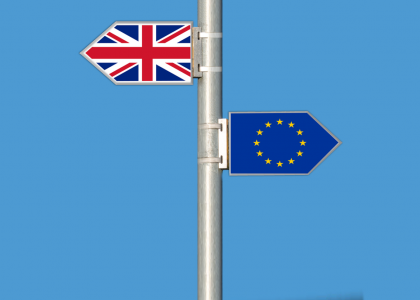What was a neglected issue during the referendum campaigns has now become the main sticking point in Brexit negotiations, and there exists no possible answer unless someone crosses a red line.
In macroeconomics, there is a concept known as the impossible trinity or the ‘trilemma’. It’s a hypothesis which says that it is impossible to achieve all three aims of; fixed foreign exchange rates, free capital mobility, and monetary policy autonomy. Instead, only two of the three are possible and a decision must be made as to which aim is sacrificed.
The Brexit negotiations have been stumped by their own seemingly unsolvable trilemma in the form of the Irish border. Brexit turns the land border on the island into an external border of the EU, and the specific circumstances of Ireland are unique. It’s one of the very few Brexit issues whereby the positions of all of the involved stakeholders are known, precise, and clear – unfortunately however, they are also incompatible. In fact, the red lines set out by the UK’s own zombie leader, Theresa May, are conflicting in and of themselves.
The first point on Theresa’s tricky triangle is avoiding a return to a hard border on the island of Ireland. This is a red line agreed upon by both sides, that physical checks and infrastructure on the 310-mile north-south border must be avoided. Not only would a hard border have a “catastrophic impact” on business, jeopardising the many small and medium-sized companies who rely on cross-Border trade, but it also risks upsetting the 1998 ‘Good Friday Agreement’ peace process.
Currently, the boundary between the two countries is all but invisible, but during the Troubles it was heavily militarized and symbolic of the conflict, as well as a target for nationalist paramilitary groups. The European Union’s rules on trade and movement, along with the Good Friday Agreement, created the conditions which allowed an open border economically and politically. Furthermore, for those who live and work straddling both countries, a hardening of the border would be an unimaginable inconvenience.
Rather than across Ireland then, perhaps the new economic border could run through the Irish Sea, east to west. This was essentially what was first drawn up by Commission and Irish negotiators in a working paper late in November 2017, and what became Paragraph 49 of the December Joint Report. It suggested that to avoid a hard border “Northern Ireland, to all intents and purposes, would have to remain in the single market for goods and the customs union”. This is because at least some regulatory alignment between the EU and Northern Ireland will be necessary to avoid a hard border. For the UK however, this is a second non-negotiable point.
In the 2017 United Kingdom general election, the Conservatives were humiliated when they lost their majority in the House of Commons. In order to form a Government, they entered into a “confidence and supply” agreement with the ideologically hard right Democratic Unionist Party, which now props up and wields power over the UK executive. As a unionist party, they object to the idea of breaking up the United Kingdom’s own common market and any creation of an internal border in the UK, that is their “blood-red line”. An east-west border is viewed as undermining the integrity of the UK itself, which would be antithetical to the concept of unionism.
Without either a north-south or east-west option, there remains only one real choice. Theresa May could decide to keep all of the UK in the single market and customs union. This would eliminate entirely the need for a border and is the only way to avoid physical checks and infrastructure on the island of Ireland, and avoid distancing Northern Ireland from the rest of the UK. Theresa May has however come to her own extreme interpretation of the referendum, which simply offered a binary choice between remaining in, and leaving the European Union. She has decided on behalf of the people that the result of the vote was one which ruled out any involvement in the customs union and single market.
This red line then, is the third and final option in the trilemma. One of the three red lines must be crossed. The United Kingdom must choose to either; remain in the single market and customs union, return a hard border to the island of Ireland, or break up the UK’s own common market. This has been the major sticking point in negotiations and so the fact that the issue of the Irish border was largely ignored and dismissed by politicians both during the referendum campaigns and Brexit negotiations is quite baffling.
The backstop is not the answer to this ‘Irish question’. Instead, it is a ‘safety net’ and an exercise of ‘constructive ambiguity’. Under the backstop the entirety of the UK enters a “single customs territory” with the EU. Essentially, there will be no tariffs on goods traded between the UK and the EU, and some trade restrictions will be removed. However, Northern Ireland will remain ‘aligned’ on some extra rules of the EU’s single market to ensure no hard border is necessary. These separate regulations for Northern Ireland mean there would be some checks on goods entering Northern Ireland from the rest of the UK, something that ”represented (the DUP’s) worst fears come to life”
Pro-Brexit MPs have also criticised the backstop as it locks the UK into an arrangement which it does not have the sovereign right to withdraw from independently. Indeed, mutual consent between the EU and UK is required to end the backstop, and Attorney General Geoffrey Cox admitted that the UK could be legally trapped within. Regardless, the backstop is a temporary measure and simply amounts to the UK having ‘kicked the can down the road’. The trilemma of the Irish border will have to be confronted eventually.
Alternatively, the UK Government have pointed towards technology as a potential solution, but so far suggestions have ranged from experimental to imaginary. It seems unwise to put a large degree of faith into the potential technological solutions that may be proposed and implemented by a country whose NHS is only now starting to phase out fax machines. Rather than the backstop or magical technology, a credible solution will only be found by crossing a red line. I suggest, that the most plausible approach is that we keep all of the UK in the single market and customs union and adopt a Soft Brexit, an option that is second only to no Brexit whatsoever.
Jonathan Poole is a UEA Politics and Economics graduate who wrote this piece as part of the final year module ‘Britain and Europe’ run by Pierre Bocquillon.





